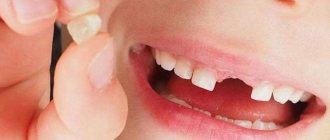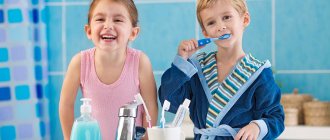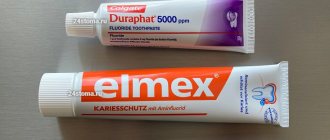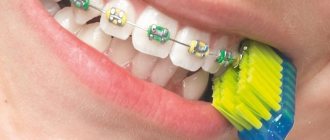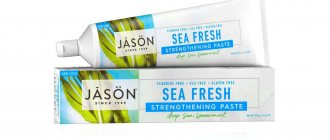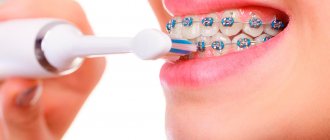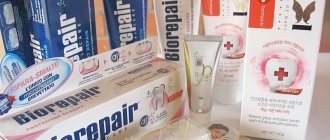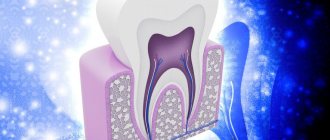There is no clear answer to the question of which toothpaste is best for brushing your teeth. After all, there is no universal means for cleaning teeth that would be able to eliminate all problems of teeth and gums. But experts have developed a range of different hygienic and preventative toothpastes that can perform specific tasks. The best option for each person is to first consult with a dentist. The dentist will objectively assess the condition of your teeth and gums, and will be able to suggest which toothpaste you should use to brush your teeth in your particular case. Your dentist will advise you on choosing a toothpaste that will provide optimal oral care. The health of your teeth will depend on the choice of toothpaste. In today's article we will talk about which toothpaste is best for brushing your teeth.
Which toothpaste is best for brushing your teeth?
Before you figure out which toothpaste you need to brush your teeth, you need to understand what tasks the ideal product should perform:
- It is good to clean the tooth surface from plaque.
- Provide protection against caries.
- Have a strengthening effect on tooth enamel.
- Combat tooth sensitivity.
- Prevent the development of inflammatory processes and bleeding gums.
- Give the teeth natural whiteness.
- Good to freshen your breath.
Every toothpaste has these effects to one degree or another. Thanks to the variety of hygiene products, you can make an informed choice and choose the best option, taking into account the characteristics of your teeth.
Everything, to the last drop
A hair clip helps squeeze out the toothpaste completely. Doctors do not advise skimping on toothpaste - it should be used in sufficient quantity, at least twice a day, and choose a product of proper quality. And good quality is not cheap. That's why everyone wants to use every last drop of toothpaste so they can throw away the empty tube. There are several tricks for this:
- Special devices. Manufacturers of various ingenious household items have long understood the desire of housewives to use the contents of tubes to the last drop. Therefore, there are various devices on sale that help squeeze out the paste to the end.
- Tricks. You can use a regular hair clip or clothespin. Pin this thing to the end of a tube of toothpaste, and then wrap the end, wrapping it around a clothespin or clip.
- Keep the toothpaste with the cap down - then the paste composition will always be closer to the hole, and will not accumulate at the end of the tube.
What toothpaste to brush your teeth with: markings
To make it easier for consumers to navigate a wide range of pastes, each product is equipped with the following markings:
- Active - refers to medicinal dental pastes. They contain antibacterial substances that suppress the activity and proliferation of pathogens in the oral cavity. That is why it is recommended to use such preparations for cleaning teeth for no longer than a month.
- White - this marking indicates that the product has a brightening effect. It is better to use whitening pastes three times a week so as not to damage the enamel.
- Sensitive - means aimed at strengthening. Excellent for people with hypersensitivity. This is the best option for long-term use.
Manufacturers use varying degrees of abrasives in pastes:
- Coarse – chalk, calcium carbonate. These substances can lead to thinning of tooth enamel. The marking of such pastes is RDA: above 80-100.
- Delicate ones - silicon dioxide, sodium metaphosphate - are aimed at gentle dissolution of soft deposits. Marking: RDA from 0 to 70.
If the question is which toothpaste can be used to brush your child’s teeth, under no circumstances should you buy products with coarse abrasives. The choice of toothpastes for children should be agreed with the pediatric dentist.
Is it possible to erase enamel with a brush and how much fluoride should be in the toothpaste?
So, the task is to maintain a white-toothed smile for as long as possible. What should you do for this, how to take care of your teeth?
Anton Krivorotov: The oral cavity is filled with various bacteria, and dental health depends on the microflora. This is why it is important to care for, and therefore brush, floss and rinse your teeth and mouth, keeping the microbiome in proper balance.
One of the main goals is to prevent tooth decay. If you have not yet accustomed yourself to regular preventative visits to the dentist, where even hints of caries will be detected and eliminated, then at least do not delay, go to the doctor at the very first symptoms of ill health. Don’t let your gums become inflamed - you definitely shouldn’t self-medicate here, no traditional salt rinses without the recommendation of a professional. Time spent experimenting on yourself can play a bad joke on your teeth.
In general, prevention rules require visiting the dentist at least twice a year without symptoms for professional oral hygiene.
You said “brush, floss (that is, use dental floss), rinse,” but how to do this correctly? They say that if you brush your teeth twice a day, you can wear away the enamel, and it will only get worse?
Anton Krivorotov: Hygiene procedures are recommended after each meal. In order to “erase” the enamel, we dentists use diamond burs that rotate at high speed. In other words, it is almost impossible to remove enamel with a toothbrush if you choose the right one and brush it correctly. Toothbrushes with unnatural bristles with medium or soft hardness are more often recommended. Movements should be sweeping, not horizontal.
To take care of your teeth, you need to start by taking care of the proper microflora in your mouth.
What is the best way to clean? They say that fluoride paste is not for daily use. Some even clean with soda and activated carbon - supposedly there are no chemicals there...
Anton Krivorotov: Fortunately, we live in a world of progress. Entire institutes are developing the composition of toothpastes, constantly improving them. Most pastes have a safety certificate, which means that studies have been conducted to confirm the effectiveness of the composition. As for home remedies, their use can be dangerous for both teeth and oral mucosa. Regarding fluoride, everything is ambiguous. The choice of fluoride toothpaste may also depend on the amount of fluoride in the water consumed. But it is better to avoid various parabens and SLS in toothpastes. Pay attention to the RDA index (abrasiveness index); it is often recommended to use pastes with minimal or medium abrasiveness.
Does it make sense to spend money on expensive pastes? Are they really better? Or are we overpaying for advertising?
Anton Krivorotov: Indeed, marketing has a great influence on the buyer. More expensive does not mean better. In my opinion, it is more important to pay attention to the composition of the paste (I recommend organic ones), to the authority and reliability of the manufacturer, and to reviews from professionals.
Is it true that daily use of mouth rinses that contain an antiseptic disrupts the microflora in the mouth?
Anton Krivorotov: Rinse aids containing alcohol are a thing of the past. Most mouth rinses do not contain antiseptic ingredients. Pay attention to the composition. I hope you are not confusing “mouthwash” with “chlorhexidine” - such solutions are not at all intended for daily oral care. Frequent rinsing with an antiseptic solution can actually disrupt the microflora.
Why do my gums bleed? When can you cope on your own and when should you run to the dentist?
Anton Krivorotov: Most often, gums bleed due to inappropriate oral hygiene. At first, a soft, barely noticeable plaque accumulates; it attracts various types of bacteria, causing inflammation.
Sometimes the reason is due to poor quality work by the dentist - for example, due to overhanging edges of restorations - fillings, crowns, vinyls. Do not ignore this symptom, because any local inflammation, including in the oral cavity, affects the functions of the body in principle. Moreover, there are a number of systemic diseases that can manifest as bleeding gums - for example, diabetes mellitus. It is important to establish the cause of bleeding and eliminate it. So here, too, a visit to the dentist will help you.
Do I need dental floss and irrigators?
Anton Krivorotov: Of course, we do. Dental floss should be with you at all times; after every meal, it is important to floss the interdental spaces. Caries between teeth (on contact surfaces) is the most sluggish and unnoticeable, which is why it is dangerous. You don't see it, but it develops. To prevent this from happening, you need to keep your interdental contacts clean.
An irrigator is an indispensable thing if you have crowns, implants or braces. It allows you to get rid of food debris in hard-to-reach places, but does not replace dental floss.
This type of care takes no more than 15-20 minutes a day. And it is very important for maintaining health.
Is it true that after an acidic food (lemon, for example) you don’t need to brush your teeth, since the acid temporarily softens the enamel and can be damaged by brushing?
Anton Krivorotov: Do not abuse the direct effect of acid (any) on your teeth. It’s not even the effect on the enamel that is so important - it’s important not to disturb the pH of the oral cavity! The mean pH of unstimulated saliva was 6.75 (range 6.2 to 7.4). By the way, there are special tests to determine PH, this is an indicator of the health of not only the oral cavity, but also other organs.
In my practice, I saw only one patient who abused lemons; she actually had a lot of enamel erosion, but this is still a rare case. After fruits containing acid, it makes sense to wait until saliva restores the desired balance, and then - please - clean.
I definitely don’t recommend rinsing your mouth with water after hot meals. Here, too, it is better to wait 10 minutes after eating hot food.
Chips cut from wild trees and bushes are African toothbrushes. Local residents claim that such “brushes” not only help keep teeth clean, but also heal, since the plants from which such sticks are made contain substances that kill bacteria that cause caries and periodontal disease. Now such sticks can even be bought in some pharmacies in the USA. During the chewing process, the sticks split into thin fibers, which work like floss - a thread for cleaning the interdental space. Photo: REUTERS
Pointed question
They say that teeth are “flying” due to COVID-19. Is it so?
Anton Krivorotov: Yes, there is evidence of the relationship between oral health and COVID-19. Namely: if there is caries in the oral cavity or even low-grade inflammation or poor hygiene (which is favorable for the proliferation of pathogenic microflora), then the risk of infection, including coronavirus, increases sharply. This happens because the entrance gate for the virus to attach is the mucous membrane of the mouth, nose and pharynx. To reduce the risk of infection, you need to get your mouth in order. I repeat: the most important thing is a healthy microflora. In collaboration with virologists, I participated in the development of a drug based on bacteriophages to normalize the microflora of the oral cavity and build immunity - similar means can be used.
Regarding the rumors that after or during COVID-19, people’s teeth “fell out” without blood, there is evidence that during the disease, blood circulation in the microvascular bed is disrupted and those vessels that fed the tooth and surrounding tissues stop doing so do. Based on this, the tooth may fall out of the socket.
Strengthening local immunity using bacteriophages will help enhance protection.
Dr. Anton Krivorotov: If you have not yet accustomed yourself to regular preventive visits to the dentist, where even hints of caries will be detected and eliminated, then at least do not delay, go to the doctor at the very first symptoms of ill health. Photo: From personal archive
By the way
Chips cut from wild trees and bushes are African toothbrushes. Local residents claim that such “brushes” not only help keep teeth clean, but also heal, since the plants from which such sticks are made contain substances that kill bacteria that cause caries and periodontal disease. Now such sticks can even be bought in some pharmacies in the USA. During the chewing process, the sticks split into thin fibers, which work like floss - a thread for cleaning the interdental space.
Anti-caries agents
It is necessary to understand that no toothpaste can cure caries. Means called “anti-caries” are aimed at protecting the dentition from carious lesions. Typically, such preparations contain a high content of calcium and fluoride. Below we consider popular options that effectively prevent the development of caries:
- PresiDENT: Unique - an Italian product aimed at strengthening enamel, has an effect. There is no fluoride in this drug, so it is suitable for use every day.
- LACALUT: Alpin - with this paste you can thoroughly clean your teeth and strengthen your tooth enamel.
- SILCA are German products that are mildly abrasive.
- Colgate Maximum Caries Protection - perfect for daily use.
- ROCS Caribbean Summer is a Russian paste that does not contain fluoride compounds.
The options listed above can be used as permanent oral care, and as auxiliary means. When choosing the appropriate option, you need to start from the key purpose of the product.
Common Myths
You can determine the expiration date of a toothpaste by looking at the colored stripe on the seam of the tube. The bar won't actually give you the answer. Many also believe that the color of the strip depends on the composition of the product and will tell about its quality, for example:
- green is used to identify herbal cleanser;
- blue indicates a natural product with mineral components;
- red indicates the medicinal properties of the product;
- black identifies the chemical base.
In fact, the color of the strip has nothing to do with the quality of the paste. It is used to identify the tube when distributing different types of product in automated plants. (See the video about the origin of the strips at the end of the article.)
Accordingly, the correct choice of a suitable product for cleaning your teeth can be made only by studying the composition and permissible shelf life, making sure in the store that they have not been exceeded on the date of purchase.
Changes in the taste or color of the product are also not related to the length of its storage. After removing the protective foil, the cleaning agent begins to come into contact with oxygen.
A change in the color, smell or taste of the cleaning mass warns a person that the process of its destruction has begun. She is no longer able to cope with her task efficiently. Brushing your teeth with such a product, at best, does not ensure the destruction of bacteria and the prevention of caries. Moreover, low-quality chemical compounds, when destroyed, can turn into hazardous substances.
The manufacturer does not indicate the expiration date of the toothpaste after opening the package. Each tube has an icon in the form of a round jar with an open lid. The icon must include a number and the letter M. In a similar way, the manufacturer indicates the maximum permissible period for using the product after opening. The numbers correspond to the number of months during which the cleaning product remains resistant to the damaging effects of oxygen. The absence of a special mark may mean that the product has not passed the appropriate certification.
If you take a serious approach to choosing a substance for cleaning your teeth, you need to pay due attention to the rules for storing the product. Only a high-quality product can achieve the desired result.
If you care about hygiene,
Which whitening paste should you use to brush your teeth?
All whitening products for oral hygiene contain abrasive elements of varying power. They have a special structure and are aimed at removing even hard deposits. Such means must be selected with special care. A strong product can damage the surface of the teeth. Compounds without abrasives can gently and carefully clean enamel, but they won’t be able to whiten it several shades. Among the popular whitening products on the modern market, it is worth highlighting the following:
- Lakalut White.
- President of White plus.
- Splat "Whitening Plus".
- Arctic white snare.
- Rox About “Delicate whitening”.
A separate line includes products for removing traces of tobacco and coffee:
- Rembrandt "Anti-tobacco and coffee".
- Dentavit “For smokers”.
- ROKS "Antitabak".
If you are unsure which whitening paste you should use to brush your teeth, you should consult your doctor before purchasing the product. The dentist will give an objective assessment of the condition of the oral cavity and tell you which means is best to brush your teeth.
How to use it correctly?
Instructions for use read as follows:
- Take a toothbrush; it is advisable to give preference to soft or medium-hard bristles. You need to moisten it a little in warm water.
- A small amount of powder must be brought to a mushy state. Pour the powder into a separate container and add a couple of drops of water.
- Dip the brush into the resulting mixture.
- Brush your teeth as usual.
You should also consider some useful tips from dentists:
- Do not try to brush your teeth with dry powder; it must be moistened with water.
- It is best to alternate tooth powder with gel paste.
- It is not recommended to use it if you have sensitive enamel.
What is better to choose to restore gums?
Brushing teeth with damaged gums is necessary only with a properly selected product. Factors that provoke damage to the mucous membrane:
- Mechanical.
- Bacterial.
- Hereditary.
Damaged tissues may begin to bleed, become inflamed, and hypersensitivity often occurs. Pastes should have an antibacterial and healing effect. Some products also perform the function of preventing the formation of tartar. Below we look at the best options:
- Forest balm.
- Parodontol Active.
- ROX Bionics.
- Splat "Lavandasept".
- President Exclusive.
Organic products
Organic toothpastes are available for all ages. You can purchase the product for both children and adults. They contain only natural ingredients. According to user reviews, these products are able to cope with their functions just as effectively as their synthetic counterparts. Such products are absolutely safe for people of all ages. On sale you can find organic pastes based on medicinal plants. They relieve inflammation well, help speed up the healing process of wounds and are excellent at fighting bleeding gums.
Which Organic Toothpaste is Best for Cleaning Teeth?
Products in this category differ favorably from others by the presence of exclusively natural ingredients in the recipe. They are often able to cope with problems of teeth and gums just as effectively as synthetic ones. At the same time, the products remain safe for health.
The formulation usually includes complexes based on plant extracts. They have anti-inflammatory, wound-healing and hemostatic properties.
- Organic People
- ROCS Bionica
- Veda Vedica
- Gum Gold
- Lavera Basis Sensitive
Organic products may contain a small amount of synthetic substances.
Pastes that do not cause allergic reactions
Modern manufacturers who produce hygiene products use advanced technologies, which makes it possible to develop products that have a powerful effect. Such pastes contain active, potent ingredients and are allergens. To avoid allergic reactions, special products are produced that do not contain aggressive substances. Instead, manufacturers add exclusively natural substances. In the ranking of the best funds of this kind:
- Weleda "With calendula".
- ROKS for children.
- Splat Zero Balance.
Rating of the best hypoallergenic hygiene products
The formulations of modern products are powerful. It is ensured due to the presence of potent components in the composition. Many of them fall into the category of allergens: strontium citrates and nitrates, parabens, triclosan, potassium pyrophosphate, etc.
To avoid irritation and other negative reactions, you need to eliminate potentially harmful substances as much as possible. Using natural ones instead: pectin, menthol, aminofluoride, silicon dioxide, etc.
- Weleda “With calendula”
- ROCS baby
- Splat Zero Balance
- Faberlic “Astronautik”
- Vilsen DENTALUX
Which toothpaste to brush your teeth when wearing braces?
While wearing braces, people need especially careful oral hygiene. Braces make the procedure more difficult. Metal components interfere with thorough cleaning of the surface of the teeth. In those areas that are tightly adjacent to the braces, deposits accumulate, gradually turning into tartar. To clean your teeth efficiently, using a brush and classic toothpaste is not enough. In this case, a different method is needed. Dentists recommend that patients with braces use special brushes and brushes. With their help, you can quickly and effectively clean even hard-to-reach areas. Among the cleaning compositions, the following are especially popular:
- ROX Pro Brackets & Ortho.
- Dentide Vitis Orthodontic.
- Biorepair Junior.
List of the best hygiene products for cleaning braces
After installing braces, oral hygiene becomes too difficult. Metal elements interfere with high-quality surface treatment. Plaque accumulates in areas directly adjacent to the braces and tartar forms.
For cleaning you have to use special brushes and brushes. At the same time, increased demands are placed on cleaning compositions. They must carefully remove dirt, but not damage the enamel and elements of the bracket system.
- Dentaid Vitis Orthodontic
- Pierrot Natural Freshness
- ROCS Pro Brackets & Ortho
- Professor Persin
- Biorepair Junior
The best products for pregnant women
Expectant mothers should pay special attention to the condition of their gums and teeth. During pregnancy, hormonal imbalances may occur, which affect the health of the oral cavity. Aggressive substances contained in some toothpastes can cause discomfort. Therefore, it is better to give preference to hypoallergenic products. Among the best options that are in demand among consumers:
- ROKS bionics “Green Country”.
- 9 months Pregnant.
- Splat Organic.
- Lakalut sensitive.
- Weleda Sole-Zahncreme.
What to do with expired toothpaste
Gel toothpaste should be thrown away, its composition completely deteriorates and is unsuitable for further use, and thrifty housewives can use regular opaque toothpaste for household work:
- Cleaning taps, mixers and plugs
in bathroom sinks. Toothpaste contains tiny natural abrasives, such as silica, that make metal surfaces shine. - Removing odor from hands
. Toothpaste contains ingredients that are used to freshen breath and remove bad breath. This can be used if you need to remove the unpleasant smell of fish, gasoline, etc. from your hands. - Removing marker from surfaces
. If there is a child in the house, he often leaves traces of felt-tip pens or markers on glass, mirrors, and cabinet furniture. Toothpaste can clean such stains: use a little toothpaste and a soft brush or microfiber cloth. - Cleaning the iron
. Sometimes a resinous residue remains on the soleplate of the iron, which accumulates over time and interferes with high-quality ironing. The abrasive composition of the paste will help cope with this, polish and clean the working surface of the iron. - Cleaning white shoes
. With a soft brush and a little toothpaste, your light-colored shoes will look clean and refreshed.
The best children's toothpastes
All parents should know at what age to brush their children's teeth with toothpaste. The market for hygiene products for children offers a variety of products for babies of different ages. Dentists recommend brushing children's first teeth immediately after they erupt. The paste must be absolutely safe, since small children do not yet know how to spit. Choose products that will provide high-quality but gentle care. Below we consider the most popular options for children:
- President baby.
- Children's splat.
- Rocks Kids.
- Lakalut Kids+.
- Colgate Junior.
Remember, pastes can only be used after consultation with a pediatric dentist. Many products may cause allergic reactions or may be inappropriate for a particular age. Therefore, the choice of children's hygiene product should be agreed with a specialist. A competent dentist will tell you what kind of toothpaste you should use to brush your child’s teeth.
Storage after opening the tube
Storing the paste in the bathroom will be more reliable if you place it vertically, with the tip of the tube down. This minimizes the interaction between the contents of the tube and the air. This storage method will somewhat slow down the oxidation process.
- It is more correct to store tubes of paste in a special closed cabinet designed for the bathroom.
- Do not forget to screw the tube cap tightly after each use of the paste, otherwise the harmful effects of oxygen on the cleaning product cannot be avoided. And if, before using the product, it turns out that the tube was not closed tightly, it is better to squeeze out the upper part and throw it away.
- After opening the tube, the composition should not be stored longer than 2 - 6 months, and for children's paste this time is reduced to 1 month.
- Most often, manufacturers indicate expiration dates for toothpastes after opening. To make it easier to find, there is an image of an open jar on the product box.

